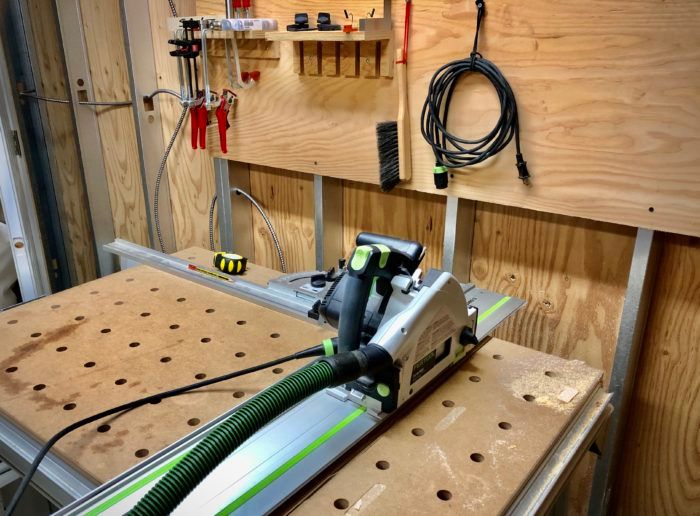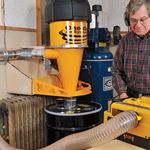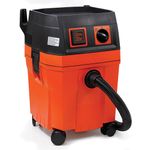Shop Machines for the Hand-Tool Woodworker
Minimalist woodworker Vic Tesolin considers the machinery of his shop his "apprentices." He leans on them to make his life easier.

Not everything I do is centered around hand tools. There … I said it. Many people know me for my book that I wrote a while back called The Minimalist Woodworker. Some of those people are shocked to find out that I use machines as part of my daily woodworking. I wrote the book because I was bothered by people telling me that they couldn’t do woodworking because they didn’t have enough space or money. Other notable excuses for not woodworking were all the excessive dust and noise. I wrote the book because I know that woodworking can be done “minimally.” Even if you don’t have the space or funds, even if you face other limitations, you can still make things from wood.
I’ve worked in shops of many different sizes, ranging from 40 sq. ft. under the basement stairs of a townhouse when I was in the military, to a couple thousand sq. ft. when I studied at Rosewood. Regardless of the space, I have continued making. Currently I have a wonderful basement shop that is around 300 sq. ft.
In that shop are machines. Machines that I call my apprentices. They do the things that I’m not interested in doing by hand, like breaking out lumber. I haven’t named any of my machines yet, but I might. I mostly run machines because I can. I have the room for them, and I have the luxury of making some noise and dust in a contained area. I’m not a production woodworker so I don’t need production machines, but I have a few that make my life a bit easier. I have many of the usual machines that most woodworkers use, but I don’t use a tablesaw or chopsaw.
 When I studied at Rosewood Studio, we were encouraged not to use the tablesaw to rip wood because the safer option was the bandsaw. This meant that the tablesaw only got used for crosscutting and dealing with sheet goods. I’ve gone many years without a tablesaw and don’t feel that I’m missing out on anything. Now that I’m in a shop that can handle swinging plywood around, I went with a track saw. I did this because it makes much more sense bringing the saw to a large sheet rather than muscling that same sheet up onto a saw table. We’ve all been there ripping big sheets on a tablesaw and we know some of the weird sounds the saw makes while we do it. The tablesaw is also a huge space hog. Another cool feature about the track saw is that I can use it to crosscut, so no need for a chopsaw.
When I studied at Rosewood Studio, we were encouraged not to use the tablesaw to rip wood because the safer option was the bandsaw. This meant that the tablesaw only got used for crosscutting and dealing with sheet goods. I’ve gone many years without a tablesaw and don’t feel that I’m missing out on anything. Now that I’m in a shop that can handle swinging plywood around, I went with a track saw. I did this because it makes much more sense bringing the saw to a large sheet rather than muscling that same sheet up onto a saw table. We’ve all been there ripping big sheets on a tablesaw and we know some of the weird sounds the saw makes while we do it. The tablesaw is also a huge space hog. Another cool feature about the track saw is that I can use it to crosscut, so no need for a chopsaw.
So yes, I use machines. I use them when I can and where they make sense to me. No matter how many machines I have, I always turn to my hand tools for certain joinery, refining surfaces, and generally anywhere that I can complete a task faster by hand tool than setting up a machine. I also turn to hand tools because I enjoy them. At the end of the day I can sleep easier knowing that if I lost my shop for whatever reason, I could turn to my hand skills to keep my love of making in wood alive.
In order to understand, you must do.
– V
 |
|
 |
Bandsaw is Better for Rough RippingAPRIL 5, 2012 |
 |
Mill Lumber SafelyJANUARY 1, 2007 |
Fine Woodworking Recommended Products


Fein Turbo II HEPA Wet/Dry Dust Extractor

Incra Miter 1000HD








Comments
Thanks Vic. For me, I don't like the dust and noise. To me, the biggest buzz kill for hand woodworking is getting wood to desired thickness. Getting one side flat with a hand plane isn't that difficult. I'm leaning towards a bandsaw with a good resaw blade. Can you please elaborate on how well this would work? How good is dust collection for a bandsaw?
If I ever did need to use much plywood, I would go with a tracksaw for all the reasons you mentioned.
The bandsaw is a great tool to have if you are only going to have one machine in your shop. Its versatile and makes short work resawing tasks as well as ripping, cross-cutting and cutting joinery. If you are worried about dust however, the bandsaw is notoriously difficult to exhaust dust from. The dust from a bandsaw is fairly coarse so most of it just falls to the ground and if paired with a dust collector, you should be fine. A dust mask would be a good plan as well. -Vic
Thanks for this article! I stumbled upon this just after watching your shop tour.
I've been turning over what my next tool purchase should be in a very new home shop. I got an old craftsman 10" table saw second-hand but it's missing the miter gauge and blade guard and doesn't feel very safe to use. I can't justify buying a cabinet saw and don't really have space anyway... Your track saw + table looks like an ideal alternative for me: safer and more accurate than what I have, can do what I need to do, and small enough to move around and store.
Thanks for the suggestion!
Log in or create an account to post a comment.
Sign up Log in